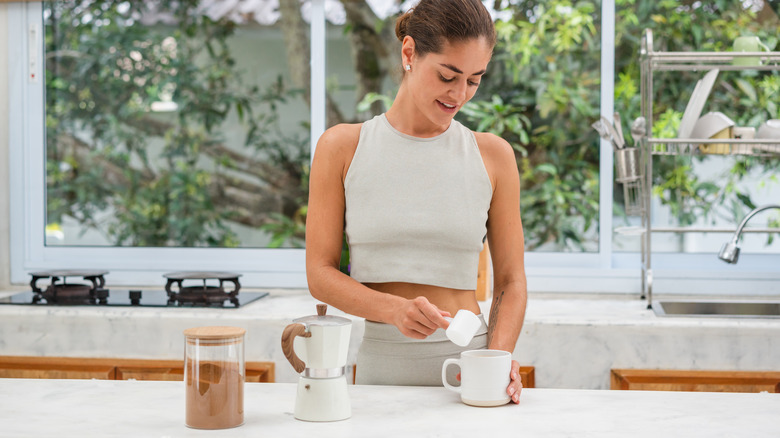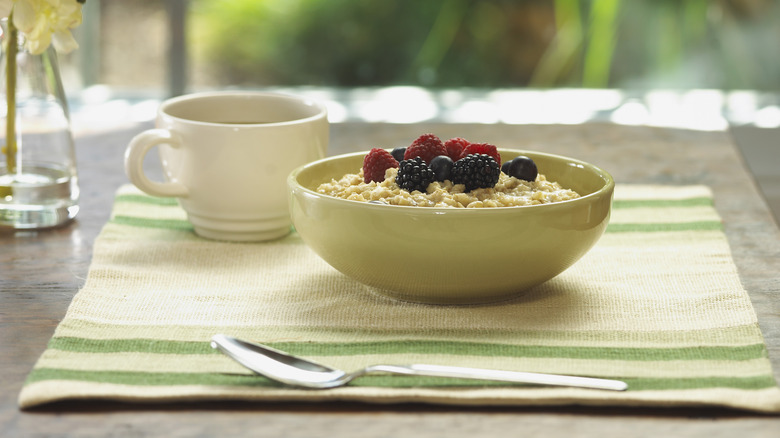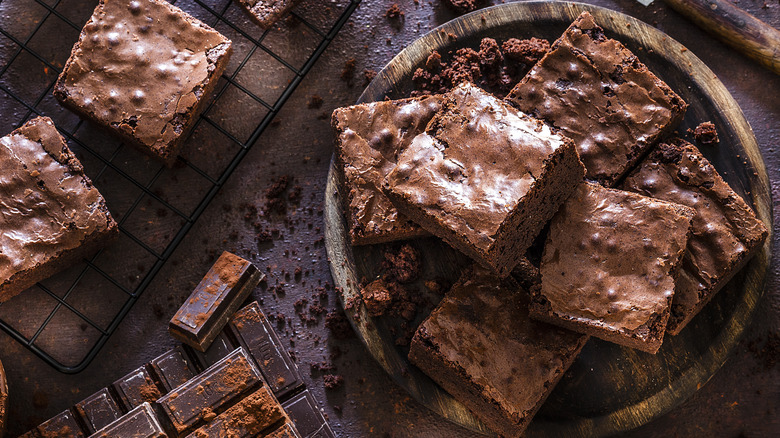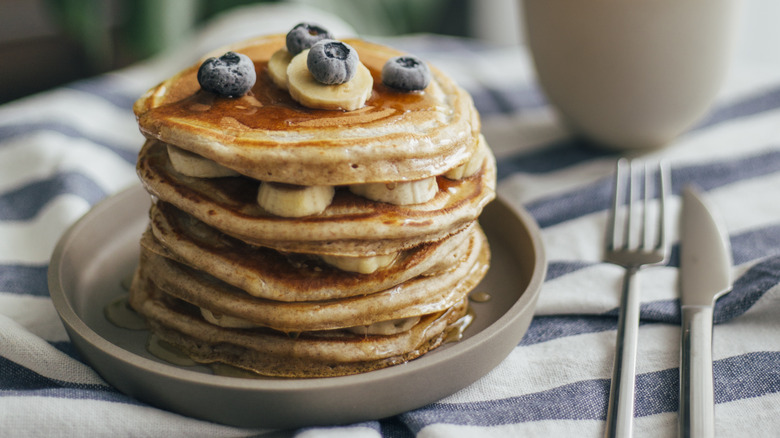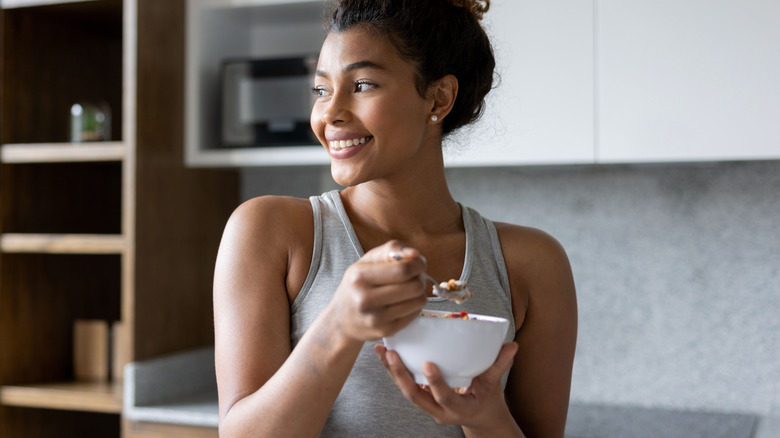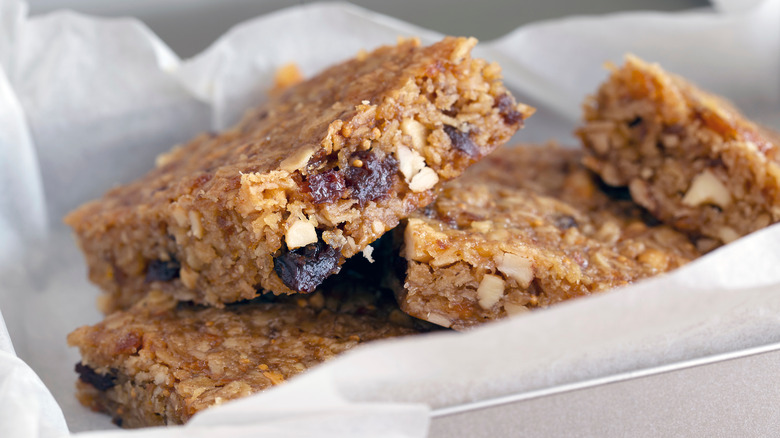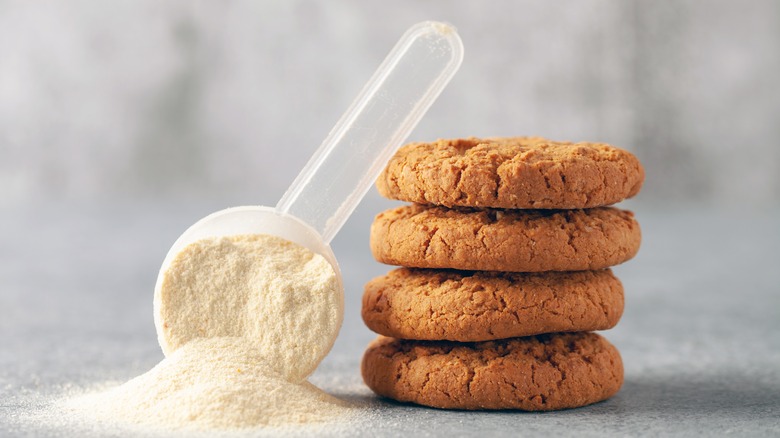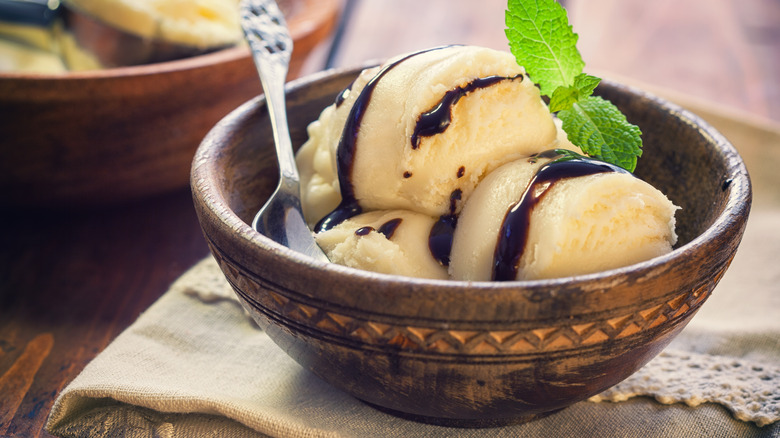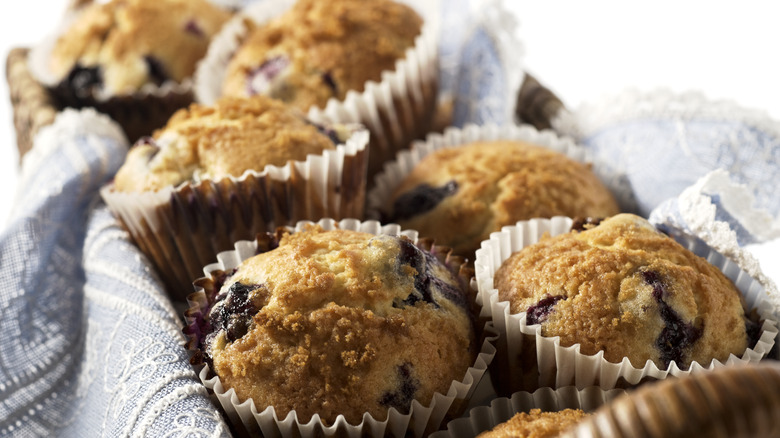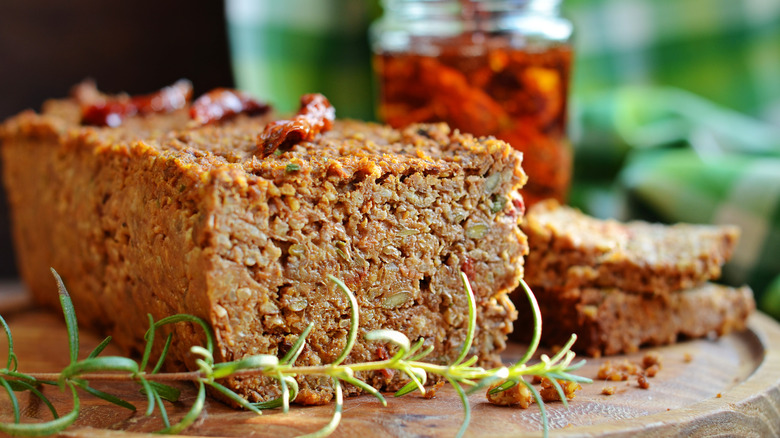Unique Ways To Sneak Protein Powder Into Your Meal Routine
Most adults need anywhere between 50 and 175 grams of protein (via the Mayo Clinic). Your protein needs increase with your level of physical activity. If you work out a lot — especially if you lift weights — you'll need more protein than someone who is sedentary. Older adults also need more protein to counteract the effects of age-related muscle loss. While many adults can get the protein they need through a well-balanced diet, those who can't meet their needs through solid food often turn to protein powder to fill in the gaps.
Protein shakes are the typical preparation method: Mix the powder with water or milk, shake, and drink. But shakes certainly aren't the only way to use protein powder. For a little variety in your life, you can ditch the shaker bottle and find creative ways to work protein powder into your meals and snacks. From a stack of protein pancakes in the morning to protein coffee for your mid-afternoon pick-me-up, there are a multitude of ways to use protein powder that can break the monotony of your daily shake.
Stir it into oatmeal
Oatmeal is one of the healthiest breakfasts you can have. It's a good source of vitamins and minerals, and it's rich in a particular type of fiber called beta glucan, which can reduce cholesterol levels and lower blood sugar. And it's also a good source of protein, with 6 grams per half cup (via the Mayo Clinic). But you can improve on that by adding protein powder. Whether you like yours with water or milk, a scoop of protein will blend nicely with the oats and any liquid you choose. And you don't have to worry about heat destroying or denaturing your protein powder, because it won't (via The Protein Chef).
You can choose your favorite type of protein powder — whey, pea, casein, hemp, or brown rice — flavored or unflavored. Once your oats are cooked, scoop in your protein powder and mix well to ensure there aren't any clumps. The oatmeal may thicken with the powder, in which case you can just add more liquid. Now comes the fun part: choosing your other mix-ins and toppings. If you want to pack in even more protein, top your oatmeal with Greek yogurt and walnuts or sliced almonds. Fresh fruit adds nutrients and a little sweetness, without added sugar.
If you're short on time in the morning, you can make overnight oats by combining all your ingredients into a container with a lid. Pop it in the fridge the night before, and in the morning you'll have creamy, high-protein oatmeal — no cooking required.
Bake it into brownies
High in fat and sugar, eating brownies is typically counter to your health and fitness goals, but everyone needs a treat now and then. If you're going to indulge in chewy, fudgy brownies, you might as well up their nutrient content by adding some protein powder. Pairing a sweet treat with protein may control the blood sugar spikes that simple carbs cause, because it helps slow digestion and delay the absorption of carbs into the bloodstream (via Beth Israel Lahey Health).
Protein powder works well in baked goods because it's not susceptible to heat and seamlessly blends in with your brownie mix. While you could use a store-bought mix, it's way healthier to make your own from scratch. A typical recipe includes wheat flour, cocoa powder, sugar, dark chocolate, eggs, and vegetable oil. To add in your protein powder, you'd substitute it for some of the flour. However, you never want to substitute protein powder for more than 1/3 of the amount of flour in the recipe (via MattsfitChef).
There are other options besides the standard brownie recipe that don't use wheat flour and can be much healthier for you. One recipe uses almond flour, protein powder, baking powder, coconut oil, eggs, and sugar (or erythritol, a sugar substitute). Another recipe uses just four ingredients — banana, almond butter, cocoa powder and protein powder — and contains no added sugar.
Whip up protein pancakes
They say breakfast is the most important meal of the day, and it's a great time to pack in some extra protein. Having a high-protein breakfast can help fill you up and keep hunger at bay until lunchtime. Also, pancakes are delicious, and just the thought of that stack on your plate gives you a good reason to jump out of bed in the morning and get going.
If you have a good boxed pancake mix you like, you can add your protein powder to it. Or you can make a classic recipe from scratch using flour, baking powder, sugar, milk, butter, and egg. Remember the rule of subbing out no more than 1/3 of the dry ingredients for protein powder. The alternative is to add more wet ingredients.
However, there are better ways to create healthy, protein-packed pancakes. One way is to use alternative flours. Almond and coconut flours are better for you than white flour (via WebMD). White flour is high-glycemic and spikes your blood sugar, which isn't good for sustained energy and focus. Almond and coconut flours are low-glycemic, providing a steady source of energy. Another healthy move is to skip the sugar in the mix. Adding bananas provides natural sweetness and moisture. And, although it's hard to imagine pancakes without syrup, your stack will be much healthier and more satiating if you top it with protein-rich Greek yogurt and fresh fruit instead.
Brew some protein coffee
Ever hear of proffee — protein coffee? It's a thing! If you're so strapped for time in the morning, just whip up a proffee and get your caffeine fix and protein in one. Proffee also makes a great afternoon protein-packed pick-me-up, especially if you're headed to the gym after work.
Proffee works best with unflavored protein powder. An easy way to make it is to first make protein milk. Combine milk (plant-based or dairy) and protein powder in a high-speed blender for 1 minute. You can also add things like vanilla extract, cinnamon, and cocoa powder to the mix before blending. Brew your coffee, and then add the protein milk mixture to it as you would regular milk. For an iced coffee, add cold brew to your milk in the blender and pour over ice. Or for a frappuccino, allow coffee and milk to cool, then blend with ice in a high-powered blender.
But what if you only drink black coffee? Can you still add protein powder to it? The answer is yes, but you need to mix it very well in a high-speed blender so you don't up with a chalky brew.
Mix it into yogurt
Yogurt is packed full of protein, with 8.5 grams per 8-ounce serving in regular and 9 grams per serving in Greek style (via MyFoodData). You can raise the protein stakes by adding a scoop or two of your favorite protein powder. Flavored and unflavored powders both work well in plain yogurt because of the latter's neutral taste. Just be sure to combine it well so you don't have any gritty, chalky surprises.
For the healthiest snack, steer clear of flavored and sweetened varieties, which are loaded with sugar. Add fresh fruit such as berries and bananas for sweetness. If you want a little crunch, stir in some low-sugar granola. You can also add other nutritious ingredients like nuts and seeds, or swirl in a little almond butter.
For an on-the-go breakfast, make a yogurt parfait in a mason jar, starting with a base of your protein-packed yogurt. Top with granola, fruit, nuts, and seeds and put it in the fridge with a lid on. In the morning, you can grab a spoon and your protein parfait and be out the door.
Make your own protein bars
Perfectly portable, protein bars are the ideal snack when you're on the go. But store-bought varieties are often loaded with refined sugar and other ingredients that can sabotage your health goals. Not to worry: With your favorite protein powder, you can make your own protein bars at home. It's quick and simple to do, and it can also save you money.
There are many ways to make your own protein bars, none of which involve baking. You'll need a base, which is typically oats. Then you'll add your protein powder and some type of liquid for moisture. Some recipes call for dairy or plant-based milk, and others use nut butters. For sweetness, you can add a little bit of honey or agave syrup. If you're watching your sugar and calorie intake, you can skip the sweetener or use a sugar substitute like stevia or monk fruit; just make sure it's well-combined in your mixture. Some recipes call for mashed banana or medjool dates, both of which can add sweetness and potentially take the place of sweetener, depending on how sweet you want your bars.
Other add-ins include cocoa powder, ground flaxseeds, chocolate chips (sugar-free or regular), cinnamon or other warm spices, vanilla extract, raisins, and dried blueberries. Once you have your mixture, spread it evenly in a shallow pan and pop it in the fridge for a couple hours. When it's firm, you can take it out and cut it into bars.
Bake a batch of protein cookies
A high-protein cookie paired with a cold glass of milk makes the perfect post-workout treat that also aids recovery. You could buy premade protein cookies at the store, but they're usually pricy and may contain a lot of sugar. Instead, make your own at home with your protein powder of choice.
Protein cookies are simple to make, and you don't even need flour. Just some nut butter, eggs, sweetener, and baking soda. If you're craving chocolate, you can add dark chocolate chips to the mix. You can also make a classic oatmeal raisin protein cookie by adding oats. Just consider whether you want to add a flavored or unflavored protein powder, as it could impact the flavor of your cookies.
Combine all the ingredients, scoop the dough onto a cookie sheet, and stick it in the oven. After baking, allow them to cool. You can eat them at room temperature or stick them in the refrigerator. This will give them a crispier texture. Keep in mind that the texture won't be exactly traditional cookies. They may be more crumbly and have a texture similar to shortbread.
Blend it into ice cream
We all scream for ice cream, but we often deny ourselves the pleasure because of its high sugar and calorie content. But ice cream isn't all created equally. High-protein ice cream made with protein powder is a delicious and nutritious way to satisfy your ice cream cravings while ensuring you meet your daily protein requirements. By using natural sweeteners and controlling the ingredients, you can create a healthier alternative to traditional ice cream that's just as indulgent.
There are tons of recipes for protein ice cream, all of them involving different levels of complexity. You can make traditional ice cream in an ice cream machine using milk, protein powder, cocoa powder, sweetener, and vanilla extract. Make sure all ingredients are well-blended, then pour the mixture into your ice cream maker and churn until solid.
However, you can also make ice cream without an ice cream maker. You can take the same ingredients listed above, blend them well, pour the mixture into ice cube trays until frozen, then blend the frozen chunks in your blender with a little more milk to get a smooth ice cream texture.
For a super simple any-night-of-the-week treat, blend frozen bananas with protein powder, Greek yogurt, and nut butter in a high-powered blender until smooth and creamy. Then scoop and serve.
Make high-protein muffins
Muffins are a beloved breakfast treat, but they often come with a hefty dose of sugar and empty calories. If you're looking for a way to indulge in your muffin cravings while also boosting your protein intake, then high-protein muffins made with protein powder are the perfect solution. Protein promotes satiety and can help with weight management by promoting feelings of fullness (via The American Journal of Clinical Nutrition). Incorporating protein into your breakfast can help you start your day with sustained energy and keep you feeling satisfied until your next meal. High-protein muffins are an excellent way to achieve this goal.
To start, you'll need whole-wheat flour. You can also use a blend of whole wheat and alternative flours like almond and coconut. Almonds are also high in protein and digest more slowly than wheat flour (via Schär). Add your protein powder, some whole oats, baking powder, baking soda and your sweetener of choice (like honey, maple syrup, brown sugar, or a sugar substitute like monkfruit). You'll also need moist ingredients like bananas, eggs, yogurt, oil, and milk, depending on the recipe you use. Next, choose what add-ins you want, such as chocolate chips, chopped nuts, or berries. Mix your batter and pour it into a muffin tin. Bake according to your recipe, allow to cool, and then savor the benefits of your protein-packed breakfast that's both satisfying and delicious.
Indulge in protein pudding
Whether you're looking to increase your protein intake, satisfy your sweet tooth, or enjoy a guilt-free dessert, making protein pudding is an excellent choice. Homemade protein pudding is easy and quick to make and allows you to control the sweetness, reducing the need for added sugars often found in store-bought desserts.
Ingredients in a basic protein pudding recipe typically include flavored or unflavored protein powder, Greek yogurt or dairy-free yogurt, plant-based or dairy milk, natural sweetener (such as honey, maple syrup, or stevia), and vanilla extract. If you're making chocolate pudding, you'll need some cocoa powder.
This is just one of your options, and there are many other recipes for protein pudding to sample. One recipe uses chia seeds and almond milk as a base with protein powder. Chia seeds form a gel when they come into contact with a liquid. When you blend them with milk in the blender, it creates a smooth, creamy mixture. Add cocoa powder and dark chocolate chips for a decadent yet healthy chocolate indulgence.
But don't stop at the pudding. Add some sliced bananas, a swirl of nut butter, some fresh or frozen berries, chopped nuts, or granola. It's so healthy, you could even eat this pudding for breakfast.
Bake a protein veggie loaf
Protein powder is often added to sweet foods, but it can just as easily be added to savory dishes. This is an easy way to add more protein to lunch or dinner. If you're vegetarian or vegan, you can use protein powder to increase the protein content of plant-based dishes, which tend to be lower in macros than animal-based meals.
Veggie loaves are delicious, nutritious, and versatile. You can eat them on their own or use them as a base for eggs or avocado. Plus, you can pack them full of nutrient-rich ingredients like veggies and beans. Unflavored protein powder will easily blend into your mix, which typically starts with a base of wholemeal flour. To that, you can add egg and cottage cheese for moisture, your protein powder, some baking powder, a little oil, and then your other ingredients of choice. Depending on the recipe you choose, this might include shredded veggies like zucchini and carrots, cheese, nuts and seeds, lentils, or even dried fruits. Put your mix into an appropriate sized baking dish and pop it in the oven until it's cooked through. It should be dense enough that you can slice it when it cools.

